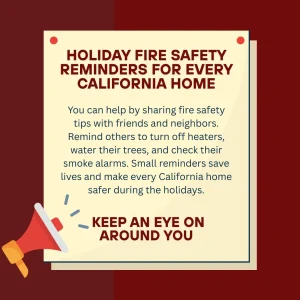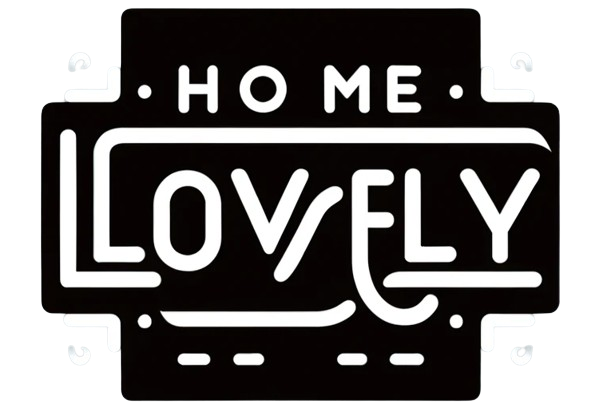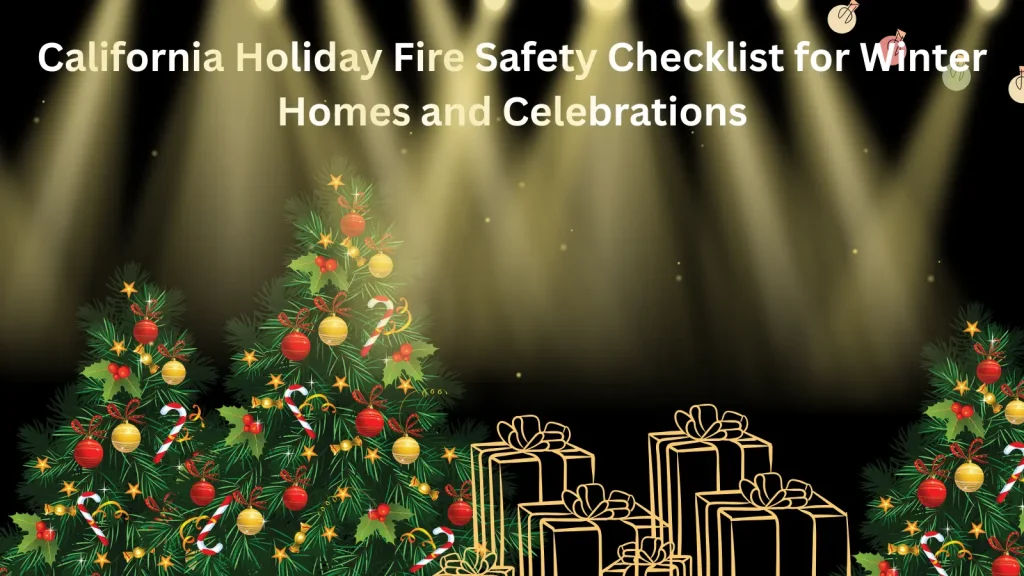As we know, the festive season has just begun. It’s an annual period that usually starts from the fourth of November till early January. Everyone calls it holiday season for a reason that it encompasses major festivals like Thanksgiving, Hanukkah, Christmas, and New Year’s Day. Festive seasons mean gatherings for friends and family, gift-giving, festive decoration, warm meals, and joyful laughter.
Just like everywhere holiday seasons look very beautiful and joyful in California. There is lightning everywhere. Families come together, they cook, play, chat and enjoy to get rid of stress and tiredness.
Decorating homes and businesses is a long-standing tradition around the holiday season. Unfortunately, these same decorations may increase your community’s chances of a fire.
Every year during the holiday season, U.S. fire departments respond to hundreds of house fires caused by decorations. These fires start with candles, lights, or wires. Initially, they seemed small but in a very short time they took control of their surroundings and destroyed everything that came in their way.
On average, about 832 house fires happen each year during holiday season, especially during decorations resulting in injuries, deaths, and millions of dollars loss. More than 4 out of 10 Christmas tree fires occur due faulty lights or electrical wires. Most Christmas tree fires start in the living room where families gather. So, these facts suggest that people seem less careful toward taking safety precautions seriously.
The risks of fire events are much higher in California as compared to other states because of our weather. In winter, the air stays dry and strong Santa Ana winds can spread flames very fast. A small spark can start a fire and turn into a big fire within minutes. Because of this, California families must be extra careful during this season.
This guide contains a Holiday Fire Safety Checklist. Follow it and keep your loved ones and celebrations safe all winter long.
Why Fire Safety Matters More in California During the Holidays
The holiday season is the time of happiness in California, just like everywhere, but this happiness just needs one spark to turn into a tragedy that can leave a mark of trauma and loss for your whole life.
We have to be very cautious in the holiday season because everyone is busy enjoying family, food, and celebration. That’s when small safety steps are easiest to forget.
Let’s discuss some of the reasons why California is on red alert for fire hazards during the festive season!
In winter, California has mild weather with low humidity and lots of dry autumn plants. Along with this, California has Santa Ana winds that blow from the mountains to Southern California. The Santa Ana winds are strong, dry winds. These winds blow at speeds of 40 to 60 miles per hour and even faster.
So, dry leaves and strong winds serve as catalysts in any fire hazard that might happen during that time of the year, making it hard for firefighters to control flames.
According to Cal Fire, strong winds and dry weather are the main causes of many winter fire flare-ups. A single spark can become a serious fire when these winds blow.
Although home décor, candles, and lighting make our homes look warm and happy, they also increase the risk of fire events. During Christmas, one of the most common and cultural components of home decoration is Christmas trees. The real trees that are used for this purpose have the potential to catch fire easily, burn down in less than one minute.
Nationwide data shows that most winter house fires start from decorations like candles, string lights, and electric heaters. These fires are common between December and January, the period of festivals and holidays.
We are not recommending that you forbid home decoration; we are only suggesting that you be cautious to make a difference.
In California, winter does not mark an end to the wildfire season fully due to dry brush and windy nights. So, it’s important to stay updated and alert with Cal Fire alerts and local county warnings. If every household takes small steps can make sure the holidays stay bright, not burning.
Read More: How Home Security Robots Are Enhancing Safety with Smart Technology
Holiday Fire Safety Checklist for California Homes
During the holiday season, days are shorter and colder. This means that we use all sorts of heating sources like fireplaces, electric space heaters, wood-burning stoves, and more to keep our gatherings warm and joyful. Moreover, holiday cooking, decorations and extra extension cords drastically increase the risk of fire. So, use the following holiday fire safety checklist to be proactive and stay safe.
Christmas Tree Safety
- Choose a fresh tree as a Christmas tree. Make sure its leaves don’t fall easily as they can act as fuel for fire
- Naturally when the tree is cut, a sticky liquid called sap flows out and seals the end of the trunk. So, cut about one inch off the bottom of the trunk before placing it in water. This removes the sap and tree starts absorbing water and wont get dry easily
- Keep your tree moist by watering it everyday so it stays fire resistant
- Maintain at least 3 feet distance between Christmas free and any flammable substance, fireplaces, heaters, and candles.
- To keep the tree moist, avoid it from placing near air vents or radiators
- Use strong and sturdy stands to keep it from tipping over.
- In case you are using an artificial tree, make sure it is fire resistant.
- Don’t keep the tree inside your home once holidays are over. They will dry out and serve as fuel for fire events.

Holiday Lights and Decoration Safety
- Don’t use lights with broken bulbs and non insulated wires.
- Don’t use LED lights that get heated soon. Use the one which stays cool and saves energy.
- Follow the manufacturer’s limit for how many light strings you can connect. If you overload or connect more strings the insulation melts due to heat leading to a short circuit.
- Turn off and unplug the lights while sleeping or going out
- Do not place extension boards and extension cords behind furniture or near rugs. Sometimes these extensions get heated and can lead to fire.
- There is a difference between indoor and outdoor lights. Outdoor lights are usually made in a way that they stay resistant to rain. So make sure not to use indoor lights outdoors because they might not qualify the safety standard of outdoor lights and may lead to hazards.
- Keep candles at least 12 inches from anything that burns.
- Use battery-powered candles for a safer glow.
- Use non-flammable decorations made of metal, glass, or fabric that resists heat.
- If power goes out, use flashlights, not candles.
Heating Safety
- Always turn off the heaters before sleeping or leaving the room. Moreover, keep the heater at least 3 feet away from any material that can catch fire easily like curtains.
- Do not use extension cords to power your heaters. Plug them directly into walls via the main electricity board.
- Use heaters with an automatic shut-off switch if they tip over.
- It is safe to use automatic shut-off switch heaters. This will protect any hazard that might happen due to tipping over.
- Don’t dry clothes near a heater or fireplace.
- Clean your chimney before using your fireplace for the season.
- If you don’t have heater do not use alternatives like oven or stove to heat your home
Fire Readiness and Emergency Tips
- Keep your fire equipment like smoke alarms well set by testing them at the end of every month. Replace their batteries twice a year so they never betray you in time of need.
- Install carbon monoxide detectors if you use gas or wood heat.
- If you use gas or wood in your fireplaces or for general purpose use, you must add a carbon monoxide detector because combustion of these fuels releases carbon monoxide. It is odorless and colorless gas that hinder Red blood cells from carrying oxygen and therefore cause suffocation.
- Always keep an active fire extinguisher in your hallways and near fireplaces. Make sure that every member of your home must know how to use it.
- Always make an escape plan to keep your family safe in case of emergency.
- Save emergency numbers (like 911 and your local fire department) on your phone.

FAQs about California Holiday Fire Safety Checklist
Why is fire safety so important during California’s holiday season?
During the holiday season, days are shorter and colder and therefore we use all sorts of heating sources to keep our gatherings warm and joyful. Moreover, holiday cooking, decorations, and extension cords add an extra layer of fire risk.
Most importantly ,the dry mild winter with strong winds blowing at speeds of 40 to 60 miles per hour and dry autumn trees and leaves serve as catalysts that fuels these fire events.
What’s the safest way to decorate my home for the holidays?
Use LED lights for decoration purposes because they don’t get hot. If you have a real Christmas tree, water it every day to prevent it from drying because dry trees can catch fire and burn easily. And never leave candles burning when you leave the room or go to sleep. In short, follow all the holiday fire safety tips I have explained above to stay proactive and safe
How can I make my home ready in case of fire this winter?
Put smoke alarms in every room and check that they work. Keep a fire extinguisher in the kitchen and near heaters. Make sure they are active and in good working condition. Check your wires and heaters to make sure nothing is broken or loose.
Are fake (artificial) Christmas trees safer than real ones?
Yes they are but keep in mind that you must buy the one that is fire resistant and won’t catch fire easily. They are safer as compared to real Christmas trees because they might get dried and catch fire easily.
What should I do if a fire starts in my home?
The first and foremost instruction is to stay calm. Secondly, try to cut off the oxygen supply to prevent the fire from spreading around. You can use a fire extinguisher for this purpose. In case of a small fire event, try to extinguish by yourself but if you feel unsafe, leave the house right away and call 911.


